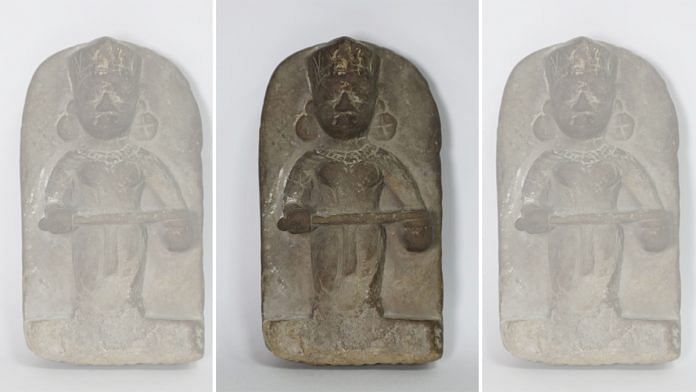New Delhi: An idol of the goddess Annapurna was installed at the Kashi Vishwanath Temple in Varanasi Monday by Uttar Pradesh CM Yogi Adityanath, more than 100 years after it had been stolen from the city.
ThePrint finds out more about the statue, its significance, and the circumstances of its retrieval.
‘Queen of Varanasi’
The 18th-century idol, measuring 17x9x4 cm, depicts Annapurna carrying a bowl of food (kheer) in one hand and a spoon in the other. In Sanskrit, the word ‘Anna’ means food/grains and ‘Purna’ means full or complete.
Annapurna idol carries a huge significance for Hindus, particularly those in Varanasi. She is worshipped not only as the goddess of food and nourishment, but also as a manifestation of goddess Parvati, the consort of Lord Shiva, one of the three deities of the Hindu holy trinity, and is thus called the ‘Queen of Varanasi’, since the city is said to be Shiva’s home.
The goddess has a temple dedicated to her in Varanasi — the Annapurna Devi Mandir.
Like many other statues of her found today, the statue now installed at the Kashi Vishwanath Temple also depicts the goddess wearing large round earrings and a necklace.
Also read: 36 antique idols, artefacts returned to India by US, Australia, UK in last 5 yrs, govt says
How the statue was stolen, and found
The statue was smuggled out of India by Norman MacKenzie, a Canadian lawyer and patron of the arts, who took the statue back to his home country from his 1913 trip to India.
At the time, the idol was reportedly located at a shrine on the riverbank of the Ganga at Varanasi. MacKenzie’s art collection later partnered with the University of Regina, Canada, and, in 1953, established the Norman MacKenzie Art Gallery to exhibit works from his collection.
Divya Mehra, a Winnipeg-based artist, while studying MacKenzie’s collection during the preparation for her exhibition ‘From India to Canada and Back to India’, brought attention to the fact that the statue had been stolen from India over a century ago.
During her research, she found that “a stranger had overheard MacKenzie’s desire to have the statue, and stole it for him from its original location — a shrine on the stone steps on the riverbank of the Ganga at Varanasi, India”, the university website stated.
Dr Siddhartha V. Shah, curator of Indian and South Asian Art at the Peabody Essex Museum, identified the statue as the Hindu goddess Annapurna.
Return delayed due to pandemic
The virtual repatriation ceremony was held on 19 November last year, with the university officially handing over the statue to Ajay Bisaria, India’s High Commissioner to Canada. However, the idol was only received by the Archaeological Survey of India (ASI) on 15 October 2021 after the long delay due to the pandemic.
Last Thursday, the Union Ministry of Culture formally handed over the idol to the Uttar Pradesh government at a ceremony held at New Delhi’s National Gallery of Modern Art.
A day to cherish the Civilisational & Cultural Glory of Bharat!
Under the relentless pursuit of the @NarendraModi Govt, #BringingOurGodsHome continues & this morning, joined by several Union Ministers, puja was performed to Annapurna Devi Murti retrieved from 🇨🇦 at @ngma_delhi. pic.twitter.com/eSqD2AAXv1
— G Kishan Reddy (@kishanreddybjp) November 11, 2021
Speaking on the occasion, G. Kishan Reddy, Union Minister For Culture, Tourism and Development of North Eastern Region, said, “The Prime Minister is striving to protect the rich heritage and culture of the country. Soon, the antiquities of various other states will be returned to the respective state governments which include two idols to Tamil Nadu and one to AP and one to Rajasthan.”
Reddy also mentioned: “Since 1976, 55 idols have been returned to India. Seventy-five per cent of the idols that have been returned were done so during the tenure of Prime Minister Shri Narendra Modi. Out of the 55 antiquities, 42 were returned after 2014 with the Annapurna Devi being the last addition to this.”
(Edited by Paramita Ghosh)



